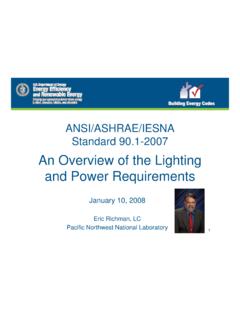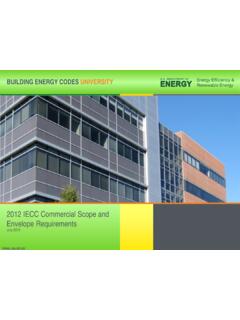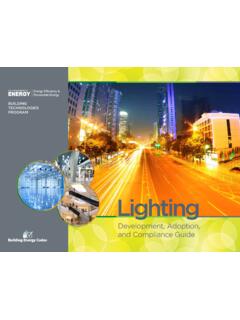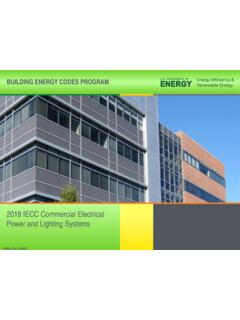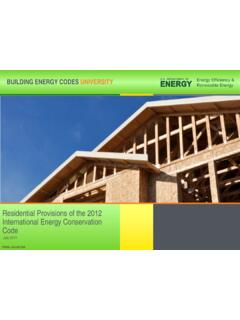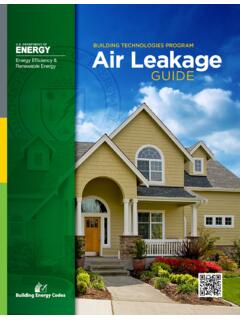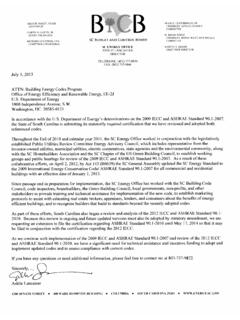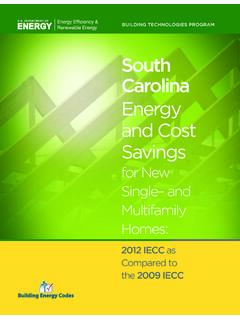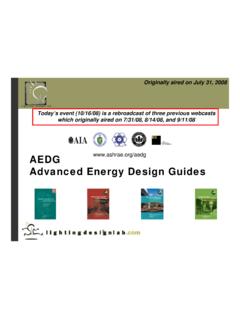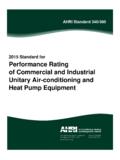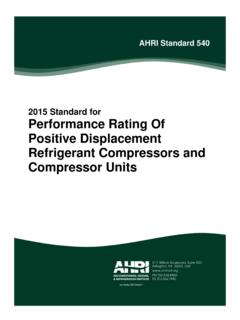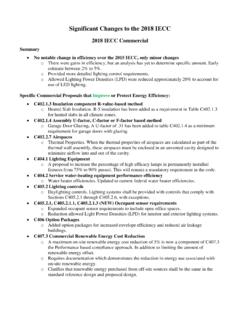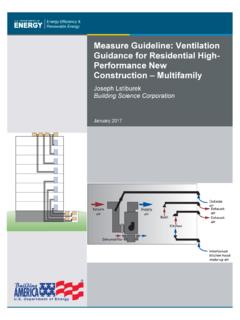Transcription of Building Energy Codes Program Commercial Program Review
1 Building Energy Codes Program . Residential Provisions of the 2015 . International Energy Conservation code Building Energy Codes . PNNL-SA-105592 Why care about IECC? Energy Codes and standards set minimum efficiency requirements for new and renovated buildings, assuring reductions in Energy use and emissions over the life of the Building . Energy Codes are a subset of Building Codes , which establish baseline requirements and govern Building construction. code buildings are more comfortable and cost-effective to operate, assuring Energy , economic and environmental benefits. Building Energy Codes The Family of I- Codes International Building code International Mechanical code International Fuel Gas code International Property Maintenance code International Fire code International Zoning code International Plumbing code International Existing Building code International Private Sewage Disposal code International Performance code International Residential code International Energy Conservation code International Wildlife-Urban Interface code Building Energy Codes Relationship Between IRC & IECC.
2 IECC addresses only Energy IRC addresses all topics (structural, plumbing, etc.). Allows builder to carry only one code book Chapter 11 covers Energy efficiency In 2015 , IECC consolidated with IRC Energy chapter (actually a change to the IRC, not the IECC) VS. IECC addresses both residential and Commercial ; IRC. addresses subset of residential, detached one- and two-family dwellings and townhouses 3 stories or fewer Building Energy Codes Structure of the 2015 IECC. Commercial Residential Section Section Ch. 1 Scope and Application / Ch. 1 Scope and Application /. Administrative and Administrative and Enforcement Enforcement Ch. 2 Definitions Ch. 2 Definitions Ch. 3 General Requirements Ch. 3 General Requirements Ch. 4 Commercial Energy Efficiency Ch. 4 Residential Energy Efficiency Ch. 5 Existing Buildings - NEW Ch. 5 Existing Buildings - NEW. Ch.
3 6 Referenced Standards Ch. 6 Referenced Standards Index Index Building Energy Codes Scope Section R101. Residential Buildings: One- and two-family dwellings, townhouses of any size and R-2, R-3, R-4 3 stories All buildings that are not residential by definition are Commercial . 1831523. Building Energy Codes Scope Section - Mixed Occupancy Section - Compliance Treat the residential occupancy under the applicable residential code Treat the Commercial occupancy under the Commercial code code Official has final authority Compliance materials, software, worksheets Building Energy Codes Scope Section Alternative Materials, Design, and Methods of Construction and Equipment The code is not intended to prevent installation of any material or prohibit design or method of construction that is not specifically prescribed in this code Such material, equipment, or design shall be approved by the code official Building Energy Codes Scope/Construction Documents Section R103.
4 Documentation shall be prepared by a registered design professional (where required). Electronic media can be used Information required: Insulation materials and R-values Fenestration U-factors, SHGC. Area-weighted U-factor and SHGC. calculations The Building thermal Mechanical, SWH, equipment types, envelope shall be sizes, and efficiencies represented Equipment and system controls Duct sealing, duct and pipe insulation and location Air sealing details Building Energy Codes Scope Section R104-R109. Inspections, R104. Successive and final inspections, and reinspections if necessary code Validity, R105. Portions of code deemed to be illegal or void shall not affect the remainder of the code Referenced Codes and standards, R106. Considered part of the requirements of the code , but IECC. provisions take precedence Fees, R107. Must be paid before permit is issued Required in accordance with schedule Stop Work Order, R108.
5 Authority of code official Failure to Comply subject to fine Board of Appeals, R109. Building Energy Codes Inspections Section R104. Construction work for which a permit is required is subject to inspection by code official or designated agent Required inspections include: Footing and foundation Framing and rough-in Plumbing rough-in Mechanical rough-in Final Building Energy Codes Referenced Codes and Standards Section Codes and standards listed in Chapter are considered part of the requirements of this code to the prescribed extent of each such reference and as further regulated in Sections and . Conflicts, where differences occur between this code and the referenced Codes and standards, provisions of this code apply Provisions in reference Codes and standards, . where the extent of the reference to a referenced code or standard includes subject matter that is within the scope of this code , the provisions of this code , as applicable, shall take precedence over the provisions in the referenced code or standard.
6 Building Energy Codes Certificate Section Permanently posted on a wall in the space where the furnace is located, a utility room or an approved location inside the Building Don't cover or obstruct the visibility of other required labels Includes the following: R-values of insulation installed for the thermal Building envelope, including ducts outside conditioned spaces U-factors and SHGC for fenestration Area-weighted U-factor and SHGC calculations Results from any required duct system and Building envelope air leakage testing HVAC efficiencies and types SWH equipment Duct sealing, duct and pipe insulation and location Air sealing details Building Energy Codes Certificate (cont'd). Certificate lists gas-fired unvented room heater , electric furnace , or baseboard electric heater , rather than listing an efficiency for those heating types Building Energy Codes Overview of Structure Climate-Specific Requirements: Roofs Above grade walls Foundations Basements Slabs Crawlspaces Skylights, windows, and doors Solar Heat Gain Coefficient in warm climates Mandatory Requirements (apply everywhere).
7 Infiltration control Duct insulation, sealing & testing, no use of Building cavities HVAC controls Piping Insulation and circulating service hot water requirements Equipment sizing Dampers Lighting Building Energy Codes Compliance IECC Terminology Prescriptive Required but can be lessened or eliminated in trade for compensating improvements elsewhere Mandatory Required and cannot be traded down, even in the simulated performance path Some elements have hard limits . aka, trade-off limits . a prescriptive requirement that can only be traded so far components can only be traded so far when complying with the performance requirements Building Energy Codes Climate Zones for the 2015 IECC. New Tropical climate zone now defined Building Energy Codes Overview of Residential code Requirements Focus is on Building envelope Ceilings, walls, windows, floors, foundations Sets insulation and fenestration levels, and solar heat gain coefficients Infiltration control - caulk and seal to prevent air leaks, and test Ducts, air handlers, filter boxes seal, insulate, and test Limited space heating, air conditioning, and water heating requirements Federal law sets most equipment efficiency requirements, not the I- Codes No appliance requirements Lighting equipment 75% of lamps to be high-efficacy lamps or 75% of lighting fixtures to have only high-efficacy lamps Building Energy Codes IECC Compliance - Four Options Energy .
8 SIMULATED. PRESCRIPTIVE PRESCRIPTIVE RATING INDEX. PERFORMANCE. (ERI). - U-factor (tradeoffs Simulated ERI. R-value (no within individual Performance Compliance tradeoffs) components) Alternative Alternative - UA (tradeoffs between R405 R406. components). Building Energy Codes Building Envelope Specific Requirements Building Thermal Envelope consists of: Fenestration Ceilings Walls Above grade Below grade attic Mass walls Floors Slabs Conditioned Space Crawlspaces Exception: Low Energy usage < Btu/ OR. 1 of floor area OR. unconditioned spaces Building Energy Codes Insulation and Fenestration Requirements by Climate Zone 21. Building Energy Codes Tropical Zone - New Section Buildings deemed to comply at elevation < 2,400 feet above sea level where the following conditions are met: < space is air conditioned Occupied space is not heated > 80% solar, wind, or other renewable Energy source supplies for service water heating SHGC on fenestration < or overhang projection factor > Lighting in accordance with R404.
9 Exterior roof complies with Table ( Commercial cool roof) or insulation of > R-15, if present, attics above insulation are vented and attics below insulation unvented Roof surface slope inch per foot of run Building Energy Codes Tropical Zone - New Section Continued Operable fenestration provides ventilation < 14% of floor area for each room or equivalent ventilation is provided by a ventilation fan Bedrooms with 2 exterior walls facing different directions have operable fenestration Interior doors to bedrooms capable of being secured open Ceiling fan or rough-in provided for bedrooms and the largest space that is not used as a bedroom Building Energy Codes Fenestration Sections Doors and windows NFRC rating or default table If no labeled U-factor and SHGC, use default table No glass area limits Exemptions Up to 15 ft2 of glazing per dwelling unit (Section ).
10 One side-hinged opaque door assembly up to 24 ft2. (Section ). Building Energy Codes Skylights Section Meet U-factor Meet SHGC. Building Energy Codes Fenestration Sections - Area-weighted Average Can be used to satisfy U-factor and SHGC requirements Subject to hard limits, even in trade-offs Building Energy Codes Fenestration Section Dynamic Glazing Dynamic glazing (New). Ratio of higher to lower labeled SHGC > Automatically controlled to modulate amount of solar gain into space in multiple steps Shall be considered separately from other fenestration (area weighted average). Exception not required to comply when both high and low rated SHGC meet Table Building Energy Codes Building Envelope Specific Requirements Building Envelope consists of: Fenestration Ceilings Walls Above grade attic Below grade Mass walls Floors Conditioned Space Slabs Crawlspaces Building Energy Codes Ceilings Section R-values are to be printed on the batt insulation or rigid foam board.
